9 basics of Windows 8
In the Microsoft BUILD conference last September, this well-known software company finally revealed its latest operating system to the public. The Windows Developer Preview, designed for IT programmers and professionals, has now reached many other users. They use this version to evaluate the new operating system for their IT work, write applications based on the new WinRT platform or simply experience.
After a period of use, we discovered some problems with this new operating system, as well as a look at the Microsoft forum to learn more about other issues users have reported. In this article, we will provide a list of top 9 issues that users encounter with Windows 8, along with some explanations and solutions.
1. New Metro screen
One of the most controversial and controversial issues in Windows 8 is Microsoft's new Start screen, a new way to launch and manage applications.

This method to direct Desktop to mobile in the future has not captured much of the community and press. Focusing on one or two tasks at the same time will reduce the user's experience. Besides, users have to constantly switch between the Start screen and the classic desktop of Windows 7 (including taskbar, desktop, explorer, .).
We can take an example of discomfort when using: when you check your email using Outlook 2010, a traditional desktop email client and a customer asks for a business data for them to refer to. . Obviously the next step is to search for the file. Problem arises: Once you click on the Start menu or press the Windows key to find the search feature, the classic screen disappears and you are directed back to the new Start screen (as shown above) by the search menu that now displays only Marketing in Metro-like environment. You search for the file, open it and will be returned to the desktop.
The same thing happens when users switch between built-in applications such as Twitter @ ama or Socialite and other applications on the Desktop. In terms of productivity, this will affect the experience that anyone can see.
Many other complaints revolve around the new interface targeting tablets and phones, making it completely useless for desktops and laptops.
Solution : Currently, there is no solution other than turning off the Start screen. After a few days of learning the new interface, we had to go back to the old screen and realized that we spent 95% of the time working on the Classic interface and couldn't consider this new method. Why? The answer is very simple: Because we don't really use Metro-type applications day in and day out. Our solution to this problem is to wait until the Beta becomes a hot version in 2012 with Windows Store and other applications.
How to change the Windows 8 Start menu to Windows 7:
If you don't like Windows 8's Start menu, here's how to change it to the version of Windows 7:
1. Open the Run window by pressing Win + R.
2. Type " regedit " (without quotes) and click OK .
3. Access HKEY_CURRENT_USERSoftwareMicrosoftWindowsCurrentVersionExplorer
4. Find the " RPEnabled " value and double click on it.
5. Change the value from 1 to 0 .
Now you have Windows 7 Start menu in Windows 8.
Besides, if you want to turn off the Start screen and return to the way of Windows 7, just download "Windows 8 Start Menu Toggle". Currently, this is the only solution for users of Windows 8, who hate the UI interface.
2. Cannot close the application
Most Windows 8 OS testers complain when there is no way to close the application: Once you open an application, it stays open until Windows 8 decides to hang it to save CPU - wear Although the application is still displayed. Although this is not a problem for ordinary users, the more professional people still have problems: The most viewed stream of events on the official Windows 8 developer forum is "Exit Developer Preview Apps (aka Closing Metro Apps) ", with all users complaining about this omission. After a heated debate, Jon DeVaan - senior vice president in charge of Windows Human System Development - said:
" Metro Style application is still not fully completed. The system automatically manages these applications from consuming background resources. Users can check application life information in the data for programmers. if you want ".
The problem is that even suspended applications consume resources (for example, internal memory consumption). In addition, when 'walking' through applications, we sometimes realize that automated applications are suspended and only work again when clicking on them via the Start screen. This is really annoying.
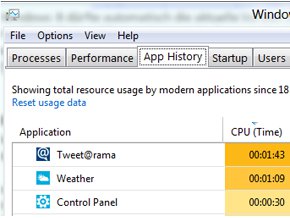
Windows 8 task manager
Solution : In Windows 8 Pre-Beta users can completely close the application by pressing ALT + F4 , although it does not work for regular applications. Or, you can use the task manager, go to the Processes tab, and close the running applications.
However, users can be happy to receive the news: Windows Division Manager, Steven Sinofsky, briefly mentioned in a blog post that there will be an easier way to close the application: ' Will Is there a way to close applications in Metro without having to use Task Manager? Yes, sure, but we also want to talk about why you don't want to use them . '
Perhaps we will have to wait until the Beta version to get a more perfect solution.
3. Discomfort with the blue Start screen
By default, the Windows 8 Start screen has a blue theme with no way to change it.
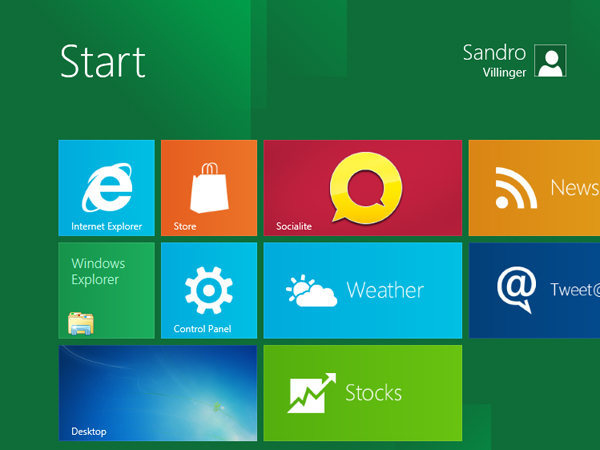
Obviously, Microsoft understands that its users like to customize the screen the way they like, so there's nothing that makes them forget about this feature in the next version of Windows 8. In fact, there has been a new (not yet released) Start screen capture that has been announced since November 5. That is the reliable factor for us to believe that we can customize this option.
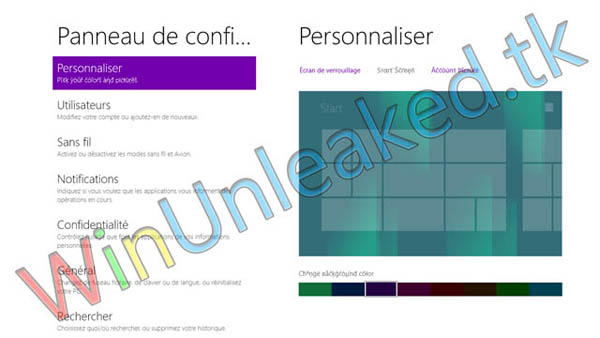
Solution : Currently, users can use My WDP Customizer 1.3.0 to change not only the Start menu's background and all other color sets, but also change the Windows 8 Start button with custom images and colors. . It will only take a few seconds to use WDP Customizer but this is the best solution right now.
4. How to turn off the computer?
At first use, it was hard to imagine but it took me about 5 minutes to figure out how to turn off Windows 8. Clicking the Start button will guide users to the new Start screen. To turn off or restart Windows 8 properly, you will have to:
- Log off , click on the Power button and select either Restart or Shutdown option
- Move the mouse over the Start button, click Settings , go to Power and select the item you want.
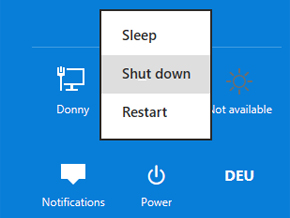
Solution : Fortunately, users can create a customized shortcut to shut down, restart, hibernate, sleep and lock the computer and then put that shortcut on the Start screen. To do so, right-click the desktop, find the New / Shortcut option, and type one of the following commands:
Shutdown: shutdown.exe –s –t 00
Restart: shutdown.exe –r -t 00
Hibernate: rundll32.exe PowrProf.dll, SetSuspendState
Sleep: rundll32.exe powrprof.dll, SetSuspendState 0.1,0
Lock: Rundll32.exe User32.dll, LockWorkStation
Name the shortcut accordingly and select the corresponding icon from the default Windows icon library:

Next, put them in the folder " % appdata% microsoftwindowsStart MenuPrograms ". Go to Windows 8 Start screen and search for each shortcut. The search results will display the icons you need to find. Right click on them and select Pin . So you can turn off the computer much easier.
5. Set the parallel window inactive
For displays with a lower resolution of 1366 x 768, the Snap feature (allows users to display 2 applications on the screen and resize them to 1/3 or 2/3 of the screen) work.
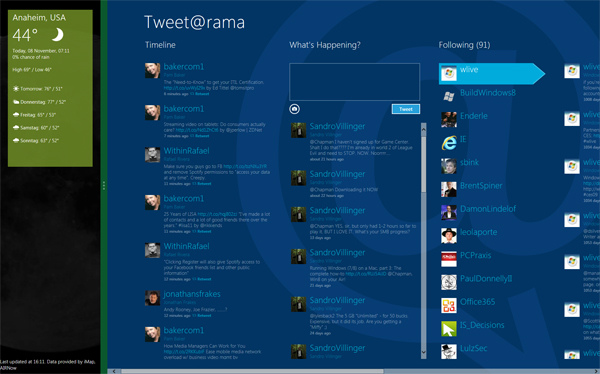
For some reason, Microsoft decided to give up the Snap feature, despite the fact that there are many mobile devices that still support 1280 x 800 resolution and can display 2 apps in full. parallel.
Solution : There is no reason for us to suffer from Microsoft's limitations. Open regedit and go to " HKEY_CURRENT_USERSoftwareMicrosoftWindowsCurrentVersionImmersiveShell ". Next, create a new key called AppPositioner . In that key, create a DWORD entry then you will rename to AlwaysEnableLSSnapping . Double-click it and then enter 1 .

Once you restart the computer, you can easily display all the applications in parallel.
6. Run Windows 8 in a virtual environment
While most users install Windows 8 on a real computer to fully experience this new operating system, some people may just want to run it for quick testing or application compatibility testing. However, the Windows Developer Preview version still causes many users to have problems using VMware or even Microsoft's own virtual machine software - VPC.
Solution : VirtualBox and VMware Workstation / Player 8 are fully capable of running Windows 8 virtualization, so remember to download and use the latest version of this software.
Hint : Remember to delete / disable the Floppy virtual drive to avoid conflicts.
7. Metro apps are no longer active
There are many system applications, Windows 8 users 'refuse' to operate or stall for a short time after displaying the boot screen.
Solution : This is a common error in Windows 8 associated with the user account control (UAC) feature. If this feature is disabled (by the user or by a 3rd party application), some applications may not work properly. To reactivate UAC, go to the Start screen, search for User Account Control and click Settings . Click Change User Account Control Settings and move the slider to the default settings. Besides, do not use Administrator account to run applications on Metro. Instead, use your own user account.
8. Windows 8 requires entering a product key
The Windows Developer Preview version is a public pre-beta version and it does not require a product key. However, there are still some users who are asked to " Please enter product key to proceed " when installing Windows, when running Windows 8 from USB or after they repair their operating system with Windows Refresh feature.
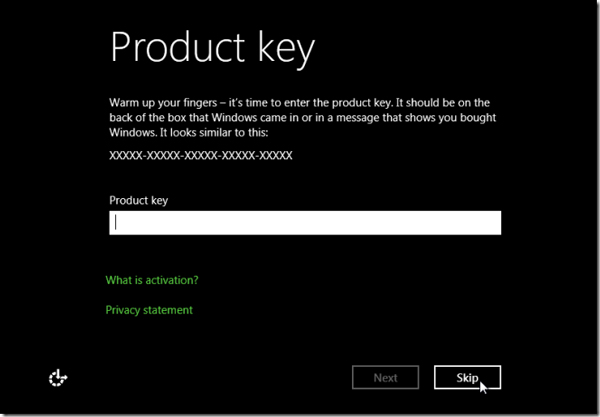
Solution : To get rid of the requirement to import product keys, Microsoft advises users to download the ISO file from the MSDN website and override everything. However, this is still not the best choice when users have to spend hours to download, install and configure Windows 8 on the computer. A faster method to solve the problem is to use the key provided by Microsoft's Support, which works with all versions of Windows 8 Developer Preview. You just fill in:
6RH4V-HNTWC-JQKG8-RFR3R-36498 (for Windows 8 Client)
4Y8N3-H7MMW-C76VJ-YD3XV-MBDKV (for Windows Server 8)
This key will help activate Windows 8 Dev Preview!
9. Lost .NET Framework 3.5
For some reason, Microsoft decided to ignore .NET Framework 3.5 from Windows 8 Developer Preview, only version 4.0 works. In case you try to install an application that requires .NET Framework 3.5, users will receive a message saying that it needs to download the necessary components. This process will take a long time (45 minutes or more) or give an error message.
Solution : Fortunately, there is a way to run the offline installer on Windows 8 Developer DVD. Just check if the DVD is already in the drive (or if the ISO file is already mounted), type the command:
dism.exe / online / enable-feature / featurename: NetFX3 / Source: x: sourcessxs
Note : X is a wildcard for a DVD or ISO drive. It will run the installer immediately.
You should read it
- How to turn off Snap feature in Windows 10
- Add the function Shutdown, Restart, Sleep to the Metro screen in Windows 8
- How to enable / disable the Aero Snap feature in Windows 10
- Instructions for using Snap feature on Windows 10 with shortcut
- How to fix 'An operating system not found' error on Windows 10 and Windows 8.1
- Instructions to prevent shutdown on Windows 10 computers
- How to fix Windows 10 not booting error
- Common errors on Windows 8 CP
May be interested
- Configure Windows Server 2008 to remotely access SSL VPN Server (Part 3)
 in the previous two articles of this series on how to create an ssl vpn server on windows server 2008, we introduced the basics of vpn connection issues, then went into the configuration of the server. . in this process,
in the previous two articles of this series on how to create an ssl vpn server on windows server 2008, we introduced the basics of vpn connection issues, then went into the configuration of the server. . in this process, - Complete tutorial of Excel 2016 (Part 5): Basics of cells and ranges
 whenever you work with excel, you will need to enter information - or content - into the cells . cells are the basic building blocks of a spreadsheet. you will need to learn the basics of cells and cell contents to calculate, analyze, and organize data in excel.
whenever you work with excel, you will need to enter information - or content - into the cells . cells are the basic building blocks of a spreadsheet. you will need to learn the basics of cells and cell contents to calculate, analyze, and organize data in excel. - Network basics: Part 14 - Security groups
 in the previous article, i have shown you how to create a security group in windows server 2003. when you introduce those things, you've probably noticed that windows will allow you to create several different types of groups as well. shown in figure a. results t
in the previous article, i have shown you how to create a security group in windows server 2003. when you introduce those things, you've probably noticed that windows will allow you to create several different types of groups as well. shown in figure a. results t - Troubleshoot service errors in Windows Server 2008 R2 - Part 1
 in this article, i will show you some of the basics of troubleshooting system service errors, including verifying error messages and checking information in event logs.
in this article, i will show you some of the basics of troubleshooting system service errors, including verifying error messages and checking information in event logs. - How to Write to a Text File in C++
 this article illustrates the process of creating and writing to a text file in c++ using the microsoft visual studio application on a windows computer. the program utilizes the basics in the c++ language and will enable you to output any...
this article illustrates the process of creating and writing to a text file in c++ using the microsoft visual studio application on a windows computer. the program utilizes the basics in the c++ language and will enable you to output any... - The basic advantages of Linux servers and Window servers
 you plan to hire a server service to build a website for small businesses, but you need to know the basics of network servers. the whole purpose and total characteristics of a website are the factors that form the server selection
you plan to hire a server service to build a website for small businesses, but you need to know the basics of network servers. the whole purpose and total characteristics of a website are the factors that form the server selection - Git and GitHub - Using Git the right way to maximize your work
 today's lesson we will learn the basics of git and github
today's lesson we will learn the basics of git and github - How to fix CPU working 100%
 this article will list the basics that cause the cpu to work 100% and how to fix it.
this article will list the basics that cause the cpu to work 100% and how to fix it. - Kubernetes Cluster Basics
 clusters are the main power of kubernetes: the ability to schedule and run containers across a group of machines, either on a physical system or in the cloud.
clusters are the main power of kubernetes: the ability to schedule and run containers across a group of machines, either on a physical system or in the cloud. - Things you need to know about 10G
 if you follow the technology news, you probably heard about 5g, the next generation of wireless technology for mobile networks, but you might not know about 10g broadband, advertised at the show. ces this year.
if you follow the technology news, you probably heard about 5g, the next generation of wireless technology for mobile networks, but you might not know about 10g broadband, advertised at the show. ces this year.










 Cleans, fixes Web-based system
Cleans, fixes Web-based system Interesting secret right on Google's search engine
Interesting secret right on Google's search engine Try using the new features of Windows 8
Try using the new features of Windows 8 Instructions against Spam
Instructions against Spam 10 things to do when you first buy a Mac
10 things to do when you first buy a Mac The secret to teaching young children about the Internet
The secret to teaching young children about the Internet